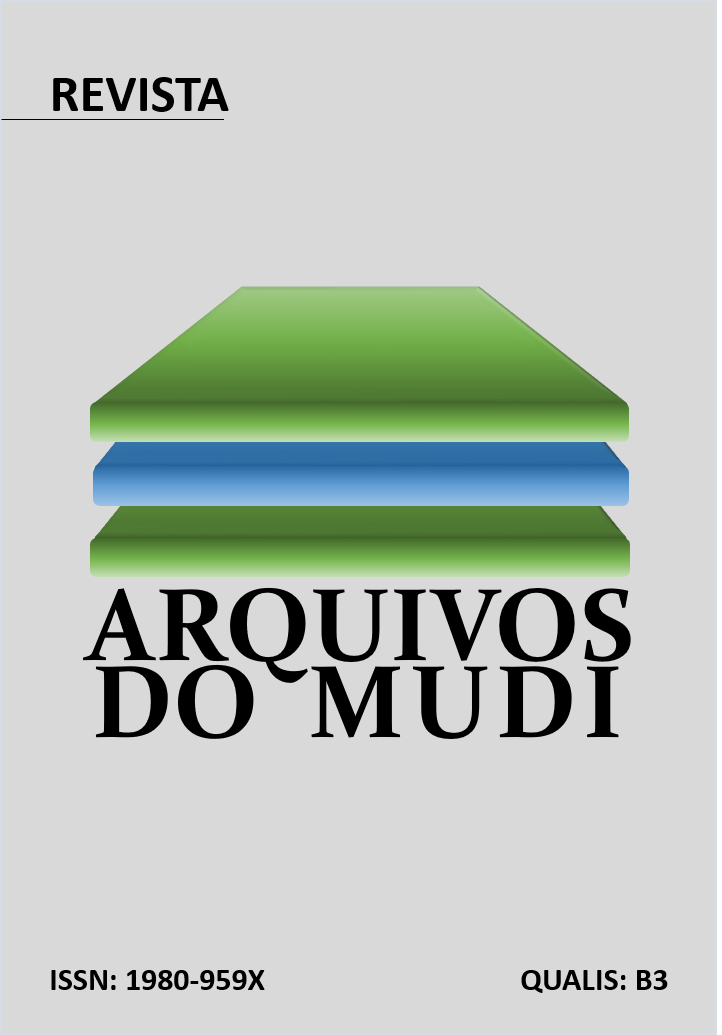Efeitos da musculação na saúde e bem-estar de pessoas sedentárias
Abstract
Introduction: a sedentary lifestyle can be characterized by behaviors such as sitting, lying down, or reclining passively, and is associated with several diseases. Weight training uses weights to generate resistance during exercise, improving physical fitness and helping to prevent diseases in those who practice it. Objective: to evaluate data from scientific literature about the effects of weight training on the health and well-being of sedentary individuals. Methods: simple literature review, using information and data from different scientific journals. Results: several studies aimed at evaluating the effects of weight training on human health have shown a positive impact on preventing and reducing the side effects of different diseases associated with a sedentary lifestyle, as well as on improving the well-being and mental health of weight training practitioners. Conclusion: it was found that adequate and regular weight training, supervised by a professional, plays a fundamental role in reducing the negative effects caused by a sedentary lifestyle and impacts the well-being of those who practice it.
Downloads
References
Kehler DS, Theou O. The impact of physical activity and sedentary behaviors on frailty levels. Mech Ageing Dev. 2019;180(1):29-41.
Organização Mundial da Saúde (OMS). Novas diretrizes sobre Exercício físico e comportamento sedentário. 2020. Disponível em: https://www.paho.org/pt/noticias/26-11-2020-oms-lanca-novas-diretrizes-sobre-atividade-fisica-e-comportamento-sedentario.
Souza TMA, Santana CM, Santos ACS, Lúcio GAC, Junior AH. Os benefícios da musculação para o emagrecimento. Rev Faipe. 2022;12(1):75-84.
Bull FC, Al-Ansari SS, Biddle S, Borodulin K, Buman MP, Cardon G, et al. World Health Organization 2020 guidelines on physical activity and sedentary behavior. Br J Sports Med. 2020;54:1451-62.
Maestroni L, Read P, Bishop C, Papadopoulos K, Suchomel TJ, Comfort P, et al. The benefits of strength training on musculoskeletal system health: practical applications for interdisciplinary care. Sports Med. 2020;50:1431-50.
Momma H, Kawakami R, Honda T, Sawada SS. Muscle-strengthening activities are associated with lower risk and mortality in major non-communicable diseases: A systematic review and meta-analysis of cohort studies. Br J Sports Med. 2022;56:755-63.
Snijders T, Aussieker T, Holwerda A, Parise G, Van Loon LJC, Verdijk LB. The concept of skeletal muscle memory: Evidence from animal and human studies. Acta Physiol. 2020. DOI: 10.1111/apha.13465.
Li J, Li J, Lu Y. Effects of resistance training on insulin sensitivity in the elderly: A meta-analysis of randomized controlled trials. J Exerc Sci Fitness. 2021;19:241-51.
Shojaa M, Stengel SV, Kohl M, Schoene D, Kemmler W. Effects of dynamic resistance exercise on bone mineral density in postmenopausal women: a systematic review and meta-analysis with special emphasis on exercise parameters. Osteoporos Int. 2020.
Isath A, et al. Exercise and cardiovascular health: A state-of-the-art review. Prog Cardiovasc Dis. 2023;79:44-52.
Mcleod JC, Stokes T, Phillips SM. Resistance exercise training as a primary countermeasure to age-related chronic disease. Front Physiol. 2019.
Yao L, Fang H, Leng W, Li J, Chang J. Effect of aerobic exercise on mental health in older adults: A meta-analysis of randomized controlled trials. Front Psychiatry. 2021;12.
An KY, Morielli AR, Kang DW, et al. Effects of exercise dose and type during breast cancer chemotherapy on longer-term patient-reported outcomes and health-related fitness: A randomized controlled trial. Int J Cancer. 2020;146:150-60.
Aydin M, Kose E, Odabas I, Bingul BM, Demirci D, Aydin Z. The effect of exercise on life quality and depression levels of breast cancer patients. Asian Pac J Cancer Prev. 2021;22(3):725-32.
Souza C, Ferraz AF, Alberto AAD, Miranda MLJ, Gama EF, Junior AJF. Atividades físicas: relações com a evolução humana e processos adaptativos do corpo humano. Ponta Grossa, PR: Atena Editora; 2020.
Goyal J, Rakhra G. Sedentarism and Chronic health problems. J Fam Med. 2024;45:239-57.
Fiuza-Luces C, Santos-Lozano A, Joyner M, Carrera-Bastos P, Picazo O, Zugaza JL, et al. Exercise benefits in cardiovascular disease: beyond attenuation of traditional risk factors. Nat Rev Cardiol. 2018;15(12):731-43.
Leao OA, Knuth AG, Meucci RD. Sedentary behavior in elderly residents from the rural area in southern Brazil. Rev Bras Epidemiol. 2020;23:e200008.
Holtermann A, Stamatakis E. Do all metabolic equivalent task units (METs) bring the same health benefits? Br J Sports Med. 2019;53(16):991-2.
Verdú E, Homs J, Boadas-Vaello P. Physiological Changes and Pathological Pain Associated with Sedentary Lifestyle-Induced Body Systems Fat Accumulation and Their Modulation by Physical Exercise. Int J Environ Res Public Health. 2021;18(13333).
Vallance JK, Gardiner PA, Lynch BM, D’Silva A, Boyle T, Taylor LM, et al. Evaluating the evidence on sitting, smoking, and health: is sitting really the new smoking? Am J Public Health. 2018;108:1478-82.
Duran AT, Romero E, Diaz KM. Is sedentary behavior a novel risk factor for cardiovascular disease? Curr Cardiol Rep. 2022;24:393-403.
Canabrava KLR, Amorim PRS, Miranda VPN, Priore SE, Franceschini SCC. Sedentary behavior and cardiovascular risk in children: A systematic review. Rev Bras Med Esporte. 2019;25(5):433-41.
Katzmarzyk PT, Powell KE, Jakicic JM, Troiano RP, Piercy K, Tennant B, et al. Sedentary behavior and health: update from the 2018 Physical Activity Guidelines Advisory Committee. Med Sci Sports Exerc. 2019;51:1227-41.
Lee SH, Son C, Yeo S, Ha IH. Cross-sectional analysis of self-reported sedentary behaviors and chronic knee pain among South Korean adults over 50 years of age in KNHANES 2013-2015. BMC Public Health. 2019;19:1375.
Li D, Yang Y, Gao Z, Zhao L, Yang X, Xu F, Yu C, Zhang X, Wang X, Wang L, Su J. Sedentary lifestyle and body composition in type 2 diabetes. Diabetol Metab Syndr. 2022;14:8.
Amaral LM, Amaral GR, Monte LKS, Silva GLO, Gadêlha JTS. Associação entre controle glicêmico em pacientes diabéticos e a redução no risco de demência: uma revisão de literatura. Braz J Hea Rev. 2020;3(3):6252-9.
Wheeler MJ, Dempsey PC, Grace MS, Ellis KA, Gardiner PA, Green DJ, Dunstan DW. Sedentary behavior as a risk factor for cognitive decline? A focus on the influence of glycemic control in brain health. Alzheimers Dement (N Y). 2017;3:291-300.
Hallgren M, et al. Cross-sectional and prospective relationships of passive and mentally active sedentary behaviours and physical activity with depression. Br J Psychiatry. 2019;21:1-7.
Werneck AO, Hoare E, Stubbs B, Sluijs EMF, Corder K. Associations between mentally passive and mentally active sedentary behaviours during adolescence and psychological distress during adulthood. Prev Med. 2021;106436.
Kandola A, Lewis G, Osborn DPJ, Stubbs B, Hayes JF. Depressive symptoms and objectively measured physical activity and sedentary behaviour throughout adolescence: a prospective cohort study. Lancet Psychiatry. 2020;7:262-71.
Hallgren M, Dunstan DW, Owen N. Passive versus mentally active sedentary behaviors and depression. Exerc Sport Sci Rev. 2020;48(1):20-7.
Souto CN. Quality of Life and Chronic Diseases: Possible Relationships. Braz J Hea Rev. 2020;3(4):8169-96.
Medrano-Urena MR, Ortega-Ruiz R, Benítez-Sillero JD. Physical fitness, Exercise self-efficacy, and Quality of life in Adulthood: A systematic Review. Int J Environ Res Public Health. 2020;17(17):6343.
Chen K, Tan Y, Lu Y, Wu J, Liu X, Zhao Y. Effect of exercise on quality of life in Parkinson’s disease: A systematic Review and Meta-Analysis. Parkinson’s Dis. 2020.
World Health Organization (WHO). Global action plan on physical activity 2018-2030: more active people for a healthier world. Geneva: WHO; 2019. Disponível em: https://who.int/ncds/prevention/physical-activity/global-action-plan-2018-2030/en/
Stricker PR, Faigenbaum AD, McCambridge TM. Resistance Training for Children and Adolescents. Pediatrics. 2020;145(6):e20201011.
Baechle TR, Earle RW. Weight training: steps to success. Human Kinetics; 2019.
Campos Filho AMG. Musculação: Bases Teóricas. Freitas Bastos; 2024. p.164.
Mendonça AN, Dcamargons GL, Souza TM, Moura AG. Qualidade de vida em idosos praticantes de musculação. Rev Científica UNIFAGOC. 2020;7(1):51-61.
Flor-Rufino C, Barrachina-Igual J, Pérez-Ros P, Pablos-Monzó A, Marntìnez-Arnau FM. Resistance training of peripheral muscles benefits respiratory parameters in older women with sarcopenia: Randomized controlled trial. Arch Gerontol Geriatr. 2023;104:104799.
Fragala MS, Cadore EL, Dorgo S, Izquierdo M, Kraemer WJ, Peterson MD, Ryan ED. Resistance training for older adults: Position statement from the national strength and conditioning association. J Strength Cond Res. 2019;33:2019–52.
Barrachina-Igual J, Martínez-Arnau FM, Pérez-Ros P, Flor-Rufino C, Sanz-Requena R, Pablos A. Effectiveness of the PROMUFRA program in prefrail, community-dwelling older people: A randomized controlled trial. Geriatr Nurs (Minneap). 2021;42:582–91.
Lavin KM, Roberts BM, Fry CS, Moro T, Rasmussen BB, Bamman MM. The importance of resistance exercise training to combat neuromuscular aging. Physiology (Bethesda). 2019;34:112-22.
Bernaldino ES, Silva FD. Os benefícios do treinamento resistido para a terceira idade. Saber Cient. 2021;10(1):1-9.
Ribeiro TP, Dantas TCN. Influência do treinamento resistido para idosos [Trabalho de Conclusão de Curso – Bacharel em Educação Física]. Brasília: Centro Universitário de Brasília – UniCEUB; 2020.
Medeiros DS. Benefícios do treinamento resistido para os idosos de Goiânia: um estudo de caso [Trabalho de Conclusão de Curso - Bacharelado em Educação Física]. Goiânia: Pontifícia Universidade Católica de Goiás; 2021.
Ryrsø CK, Dungu AM, Hegelund MH, Faurholt-Jepsen D, Pedersen BK, Ritz C, et al. Physical Inactivity and Sedentarism during and after Admission with Community-Acquired Pneumonia and the Risk of Readmission and Mortality: A Prospective Cohort Study. J Clin Med. 2022;11:5923.
Paluch AE, Boyer WR, Franklin BA, Laddu D, Lobelo F, Lee DC, et al. Resistance exercise training in individuals with and without cardiovascular disease: 2023 update: a scientific statement from the American Heart Association. Circulation. 2024;149(3):e217-e31.
Gilchrist SC, Howard VJ, Akinyemiju T, Judd SE, Cushman M, Hooker SP, Diaz KM. Association of Sedentary Behavior with Cancer Mortality in Middle-aged and Older US Adults. JAMA Oncol. 2020;6(8):1210-7.
Hermelink R, Leitzmann MF, Markozannes G, Tsilidis K, Pukrop T, Berger F, et al. Sedentary behavior and cancer–an umbrella review and meta-analysis. Eur J Epidemiol. 2022;37(5):447-60.
Friedenreich CM, Ryder-Burbidge C, McNeil J. Physical activity, obesity and sedentary behavior in cancer etiology: epidemiologic evidence and biologic mechanisms. Mol Oncol. 2020;15(3):790-800.
Houben LHP, Overkamp M, Van Kraaij P, Trommelen J, Van Roermund JGH, De Vries P, et al. Resistance Exercise Training Increases Muscle Mass and Strength in Prostate Cancer Patients on Androgen Deprivation Therapy. Med Sci Sports Exerc. 2023;55(4):614-24.
McLeod JC, Stokes T, Phillips SM. Resistance exercise training as a primary countermeasure to age-related chronic disease. Front Physiol. 2019;10:645.
Heissel A, Heinen D, Brokmeier LL, et al. Exercise as medicine for depressive symptoms? A systematic review and meta-analysis with meta-regression. [Journal Title]. 2023;57:1049-57.
Shannon S, Shevlin M, Brick N, Gavin B. Frequency, intensity and duration of muscle strengthening activity and associations with mental health. J Affect Disord. 2023;325:41-7.
Coelho-Junior H, Marzetti E, Calvani R, Picca A, Arai H, Uchida M. Resistance training improves cognitive function in older adults with different cognitive status: a systematic review and meta-analysis. Aging Ment Health. 2020;1-12.
Umesh HJ, Reddy RM. Effect of circuit resistance training on mental health among 15 to 18 years boys. Int J Res Anal Rev. 2019;6(1):500-3.
Bezerra MAA, Santos FJG, Bezerra GGO, Vitor RCS, Bottcher LB. Incidência de lesões e sistemas de treinamento de praticantes de musculação. Rev Encontros Cient UNIVS. 2020;2(1):19-26.
Alqarni AM. Common injuries in resistance training. Saudi J Sports Med. 2019;19:38-42.
Bonilla DA, Cardozo LA, Vélez-Gutiérrez JM, Arévalo-Rodríguez A, Vargas-Molina S, Stout JR, et al. Exercise Selection and Common Injuries in Fitness Centers: A Systematic Integrative Review and Practical Recommendations. Int J Environ Res Public Health. 2022;19:12710.
DECLARAÇÃO DE ORIGINALIDADE E DIREITOS AUTORAIS
Declaro que o presente artigo é original, não tendo sido submetido à publicação em qualquer outro periódico nacional ou internacional, quer seja em parte ou em sua totalidade.
Os direitos autorais pertencem exclusivamente aos autores. Os direitos de licenciamento utilizados pelo periódico é a licença Creative Commons Attribution 4.0 (CC BY ): são permitidos o acompartilhamento (cópia e distribuição do material em qualqer meio ou formato) e adaptação (remix, transformação e criação de material a partir do conteúdo assim licenciado para quaisquer fins, inclusive comerciais.

Recomenda-se a leitura desse link para maiores informações sobre o tema: fornecimento de créditos e referências de forma correta, entre outros detalhes cruciais para uso adequado do material licenciado.

















